
Sterilizations, IUDs, and Coercive Birth Prevention: The CCP’s Campaign to Suppress Uyghur Birth Rates in Xinjiang
Publication: China Brief Volume: 20 Issue: 12
By:
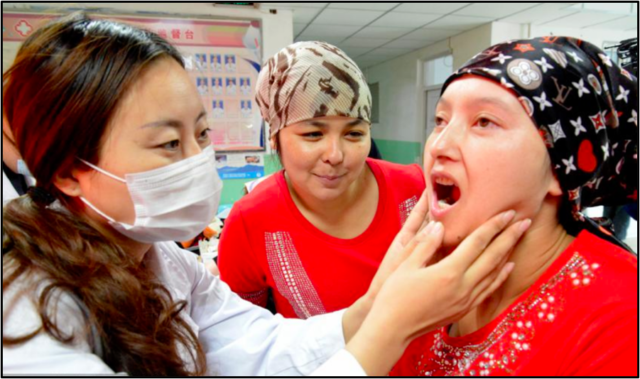
ARTICLE UPDATED October 2, 2021
Editor’s Note: This article is an abridged version of a longer and more detailed report by Dr. Zenz, which was published by the Jamestown Foundation on June 28. The full-length report, to include a large volume of supporting data, is available here. The Associated Press has also published reporting based on Dr. Zenz’s research, which includes further personal accounts from persons affected by the repressive policies detailed in the report. Even in abridged form, this China Brief article is significantly longer than our usual standards; but in light of the significance of Dr. Zenz’s research, we are making an exception to our normal guidelines.
Introduction
A sweeping crackdown starting in late 2016 transformed Xinjiang into a draconian police state (China Brief, September 21, 2017). While state control over reproduction has long been a common part of the birth control regime in the People’s Republic of China (PRC), the situation in Xinjiang has become especially severe following a policy of mass internment initiated in early 2017 (China Brief, May 15, 2018) by officials of the ruling Chinese Communist Party (CCP).
In 2019, a growing number of witnesses testified to the fact that Xinjiang authorities were administering unknown drugs and injections to women in detention, forcibly implanting intrauterine contraceptive devices (IUDs) prior to internment, coercing women to accept surgical sterilization, and using internment as punishment for birth control violations (Washington Post, November 17, 2019; Associated Press, November 26, 2018: Washington Post, October 5, 2019). These initial claims were recently further corroborated by additional testimonies (Associated Press, June 28).
For the first time, the veracity and scale of these anecdotal accounts can be confirmed through a systematic analysis of government documents. Key findings include:
- Natural population growth in Xinjiang’s minority regions declined dramatically since 2017. Growth rates fell by 84 percent in the two largest Uyghur prefectures between 2015 and 2018, and declined further in several minority regions in 2019. For 2020, one Uyghur region set a near-zero birth rate target of 1.05 per mille.
- Government documents bluntly mandate that birth control violations are punishable by extrajudicial internment.
- Documents reveal a targeted campaign of promoting “free” birth prevention surgeries and services in southern Xinjiang’s rural minority regions starting in 2019, with two counties publishing targets for sterilizing up to 34 percent of all rural females of reproductive age in 2019 alone. This project had sufficient funding for performing hundreds of thousands of tubal ligation sterilization procedures in 2019 and 2020, with at least one region receiving additional central government funding.
- By 2019, Xinjiang planned to subject at least 80 percent of women of childbearing age in the rural southern four minority prefectures to intrusive birth prevention surgeries (IUDs or sterilizations). In 2018, Xinjiang performed 963 net added IUD placements (calculated as placements minus removals) per 100,000 of the population, far higher than the national average of 21.5.
- Between 2015 and 2018, about 860,000 ethnic Han residents left Xinjiang, while up to 2 million new residents were added to Xinjiang’s Han majority regions. These figures raise concerns that Beijing is doubling down on a policy of Han settler colonialism.
These findings provide the strongest evidence yet that Beijing’s policies in Xinjiang meet one of the genocide criteria cited in the U.N. Convention on the Prevention and Punishment of the Crime of Genocide, namely that of Section D of Article II: “imposing measures intended to prevent births within the [targeted] group” (United Nations, December 9, 1948).
1. Ethnic Population Growth Trends in Xinjiang: From “Excess” to Near-Stagnation
1.1 Han Versus Uyghur Population Shares
Since 1949, the Chinese government has increased control over the remote Xinjiang region by dramatically increasing the number of ethnic Han Chinese residents. Between 1949 and 1978, their population share grew from 6.7 percent to 41.6 percent. [1] Han in-migration received another boost in the late 1990s and early 2000s (see Figures 1, 2, 3).

By 2018, however, Han population shares had declined to 31.6 percent. Between 2015 and 2018, Xinjiang’s Han population declined by an estimated 863,000. [2] Between 2005 and 2015, Uyghur annualized population growth was 2.6 times higher than that of Xinjiang’s Han, outpacing Han growth rates by a greater margin than during any 10-year period since 1965 (see Figure 2).
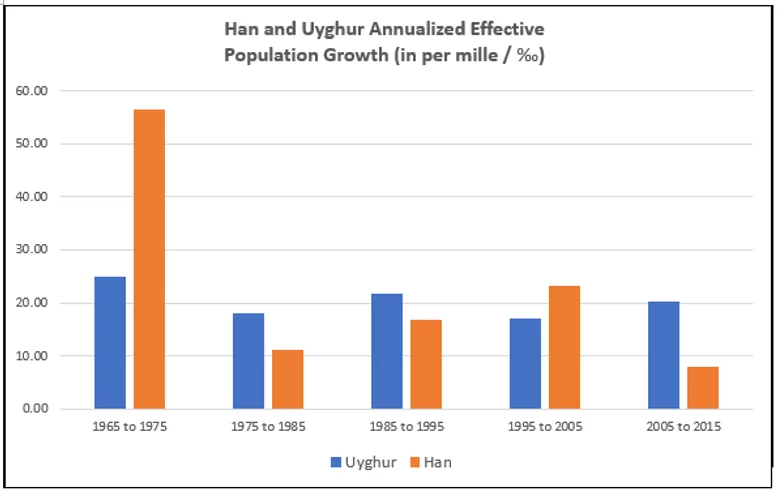
However, between 2015 and 2018, 2.03 million residents entered Xinjiang from other parts of China (see Figure 3). [3] Of these, 1.29 million were reported in Urumqi, and 0.71 million in Xinjiang Construction and Production Corps (a paramilitary settler force that engages especially in agriculture and cotton production) (XPCC) regions—all regions with Han majority populations. [4] Consequently, Xinjiang’s actual Han population share in 2018 can be estimated at 39.8 percent, near its historical peak. [5]

While no ethnic breakdowns for permanent resident populations are provided, this most likely conceals a massive influx of Han, many of whom have been lured to Xinjiang with promises of stable employment, high wages, free housing and other types of subsidies (XPCC, February 13).
1.2 Population Growth, Religious “Extremism” and Social Stability
Xinjiang’s Han Chinese academic and government circles have consistently described minority population growth as “excessive” (过分, guofen). According to a paper published in April 2017 by Li Xiaoxia, Director of the Institute of Sociology at the Xinjiang Academy of Social Sciences, Uyghur population growth rates in regions that have been traditionally dominated by Uyghurs have exacerbated spatial ethnic segregation. This “weakens national identity and identification with the Chinese Nation-Race (中华民族, Zhonghua Minzu), [thereby] impacting long-term rule and stability (长治久安, changzhi jiu’an)” (PKU Thesis, 2017). “Excessive” Uyghur population growth is in turn linked to “religious extremism”. To quote: “it is undeniable that the wave of extremist religious thinking has fueled a resurgence in birth rates in Xinjiang’s southern regions with concentrated Uyghur populations” (Journal of Ethnology, 2016).
In Xinjiang government circles, the relationship between “religious extremism” and population growth became prominent from 2015, with a May 2015 government teaching broadcast on ethnic unity stating that “religious extremism begets … illegal extra births” (Ili Prefecture Government, May 21, 2015).
1.3 Xinjiang’s Natural Population Growth Trends
Population growth in minority counties began to decline in 2015—the very year that the government began to single out the link between population growth and “religious extremism” (see Figure 4). [6]
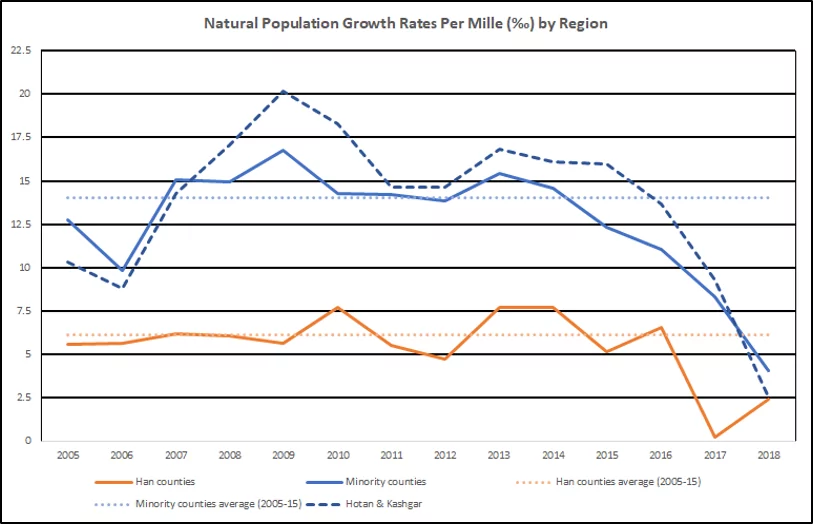
In 2018, minority natural population growth rates declined dramatically: to 4.06‰ in all minority regions and 2.58‰ in Kashgar and Hotan. The declines were most drastic in the Uyghur countryside. Keriya County in Hotan had one of Xinjiang’s highest natural population growth rates in previous years, but by 2018 that growth turned negative (to -0.49‰).
Birth rates in minority regions declined further in 2019, with declines ranging between 30 and 56 percent (e.g. Kizilsu Prefecture, April 2; Qira County, June 1; Qiemo County, April 4). Some minority regions such as Kashgar Prefecture stopped reporting their birth rates in 2019 (Kashgar Prefecture, May 9). Kizilsu Prefecture, a minority region, reduced its target birth rate for 2020 to an unprecedented low of 1.05‰ (from 19.66‰ in 2018), to be achieved through “family planning work.” [7]
Overall, it is clear that population growth in 2018 was not only depressed by the mass internment campaign, but also as the result of draconian new birth prevention measures.
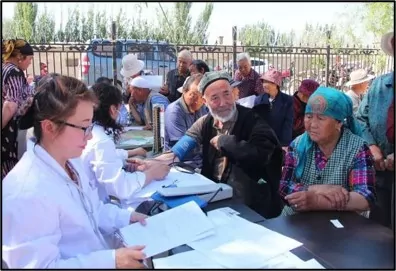
2. “Severely Crack Down on Illegal Births”: Xinjiang’s Minority Birth Control Policies and Practices from 2017 to 2019
2.1 Punishing Birth Control Violations with Internment
Prior to 2015, it was common for Uyghurs to have children in excess of state-mandated limits. When caught, they simply paid fines. As Xinjiang’s surveillance state grew and state intrusion into Uyghur families deepened, this changed drastically. In July 2017 Xinjiang reformed its family planning policy (Xinjiang Health Commission). Previously, urban Han Chinese were permitted to have one child, while urban minorities could have two. Rural residents could have one additional child: two for rural Han, and three for rural minorities. The new policy removed this ethnic distinction, permitting the Han to have the same number of children as the minorities. Minority birth quotas remained unchanged.
In 2018, Xinjiang issued a regionwide directive titled “Autonomous Region Health and Family Planning Committee Notice Regarding Continuing to Deeper Implement the Special Campaign to Control Birth Control Violations” (自治区卫生计生委《关于持续深入开展违法生育专项治理工作的通知》/ Zizhiqu Weisheng Jishengwei Guanyu Chixu Shenru Kaizhan Weifa Shengyu Zhuanxiang Zhili Gongzuo de Tongzhi). [8]
The campaign led to a much more draconian punishment of birth control policy violations, with three counties specifically mandating extrajudicial internment. On May 30, 2018, Qiemo County (Bayingol Prefecture) issued a notice stating that violations that took place since July 28, 2017, and where women had exceeded the birth quota by two or more children, must “both adopt birth control measures with long-term effectiveness and be subjected to vocational skills education and training” (同时采取长效节育措施并进行职业技能教育培训, tongshi caiqu changxiao jieyu cuoshi bingjin jinxing zhiye jineng jiaoyu peixun) (Qiemo County Government). The latter phrase is a euphemism for Vocational Training Internment Camps (VTICs), a common form of extrajudicial internment (Journal of Political Risk, November 24, 2019). In Xinjiang, the term “birth control measures with long-term effectiveness” (长效节育措施, changxiao jieyu cuoshi) essentially refers to either IUDs (节育环, jieyu huan) or sterilizations (结扎, jieza). [9] Two other minority counties issued similar directives to punish birth control policy violations with internment (Nilka County, November 20, 2019; Qapqal County). [10]
These documents confirm evidence from the Karakax List—a leaked government document from Karakax (Moyu) County—where the most frequently cited internment reason was a violation of birth control regulations (Journal of Political Risk, February 17; see Figure 5). Often, those interned had only had one illegal child. Many of them were interned in the spring of 2018, when the new punishments had been or were about to be enacted. [11] Karakax’s 2018 government work report stated that “[by] severely curbing behaviors that violate birth control [policies], birth and natural population growth rates declined dramatically.” [12]

2.2 Intrusive Birth Control Measures: IUDs
By 2019, Xinjiang planned for over 80 percent of women of childbearing age in the rural southern four minority prefectures to be subjected to “birth control measures with long-term effectiveness” (长效避孕率, changxiao biyun lu) (Xinjiang Health Commission, January 29, 2019). [13] This was to be verified through quarterly IUD checks (see Table 1).
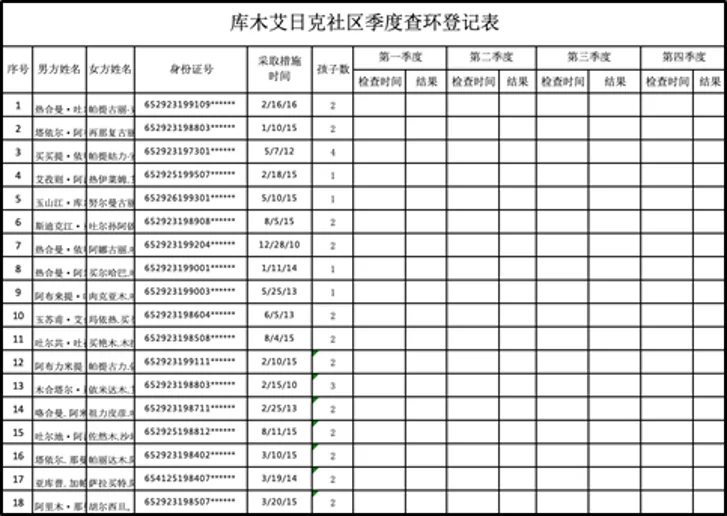
The urgent and involuntary nature of this measure is reflected in Bayingol Prefecture’s related stipulation (Bayingol Prefecture Government, May 10, 2018), which says:
After checking… all [women] that meet IUD placement conditions and are without contraindications must have them placed immediately. If there are contraindications, a diagnosis certificate must be issued at a minimum by a level-two health care institution, and follow-up must be strengthened.
In 2014, Xinjiang fitted 545 net added IUDs (calculated as placements minus removals) per 100,000 of the population, compared to 362 in China as a whole. [14] In 2018, Xinjiang fitted 963 net added IUDs per 100,000 of the population, while the national average declined to 21.5 in the wake of loosened birth control restrictions (see Figure 6). [15]
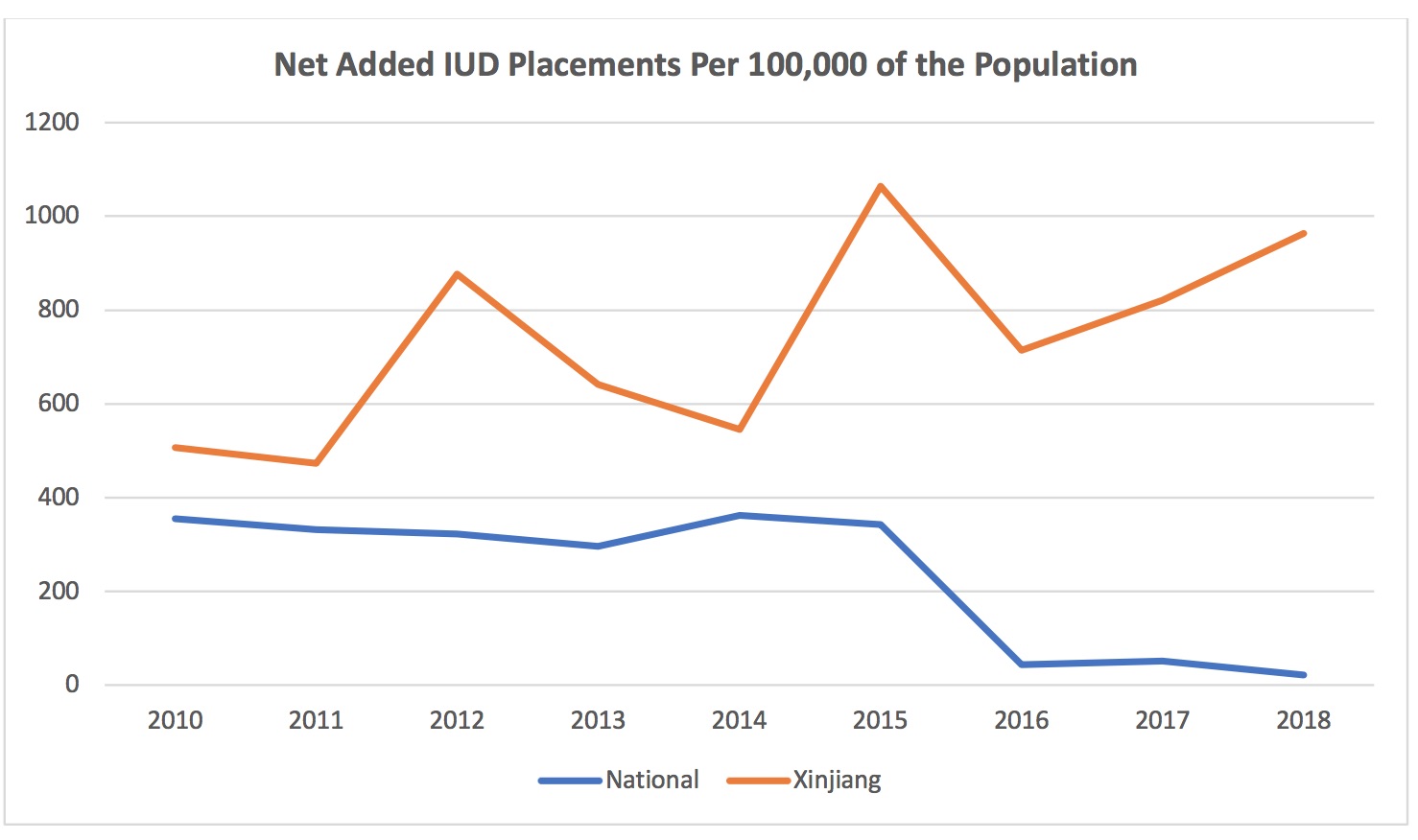
Figure 6. Net Added IUD Placements per 100,000 of the Population. New IUD placements are estimated as total placements minus removals. Sources: Annual Health and Hygiene Statistical Yearbooks, tables 8-8-2.
2.3 Intrusive Birth Control Measures: Sterilizations
In 2018, Zumrat Dawut was offered “free” surgical sterilization and threatened with internment if she refused. According to her Uyghur doctor, her tubal ligation sterilization procedure was done in the irreversible way.
The related initiative of “Free Technical Family Planning Services to Farmers and Pastoralists” (农牧民计划生育免费技术服务项目, Nongmumin Jihua Shengyu Mianfei Jishu Fuwu Xiangmu) featured in the family planning documents of numerous regions, starting in 2017 (Kashgar City; Hotan City; Tekes County; Bole City; Qitai County). (Note: Further data about this program is available in the appendix to the full-length report on which this article is based, pp. 21-24.)
In 2018, the year that Dawut was forcibly sterilized, Kizilsu Prefecture published this blunt statement, explicitly linking the “free birth control surgery” campaign with an intention to move towards mass sterilizing rural populations:
Guide the masses of farmers and herdsmen to spontaneously carry out family planning sterilization surgery, implement the free policy of birth control surgery, effectively promote family planning work, and effectively control excessive population growth. [16]
In 2019 and 2020, the Xinjiang’s Health Commission budgeted $37 million (260 million RMB) for free “birth control surgeries” (节育手术, jieyu shoushu) to all four southern regions in Xinjiang—to include health checks, IUD services, abortions, and sterilizations—with the aim to reduce these regions’ 2020 birth and population growth rates by “at least” 4 per mille points below the 2016 level. [17]
Numerous local family planning documents testify to the ubiquitous nature of this initiative from 2018, but especially in 2019 and 2020. The author has identified related project descriptions for those two years that specifically mention free sterilization procedures in at least eight minority counties (see the appendix to the full-length report, pp. 21-24). In Guma (Pishan) County, the 2019 family planning budget plan specifically called for 8,064 female sterilizations (结扎, jieza)—as well as 5,970 IUD placements. [18] In the same year, Hotan City set a “target” (目标, mubiao) to administer 14,872 female sterilizations (Hotan City, March 20, 2019). [19]
Nationwide, per capita sterilization procedures plummeted after the national family planning reform, which from January 2016 permitted Chinese citizens to have two children (China Brief, February 28). In sharp contrast, sterilizations in Xinjiang surged in 2017 and 2018 (see Figure 7). In 2018, Xinjiang sterilized 1.1 percent of all married women of childbearing age. For 2019, Hotan City was scheduled to do the same to 34.3 percent of such women, and Guma County to 14.1 percent of them.
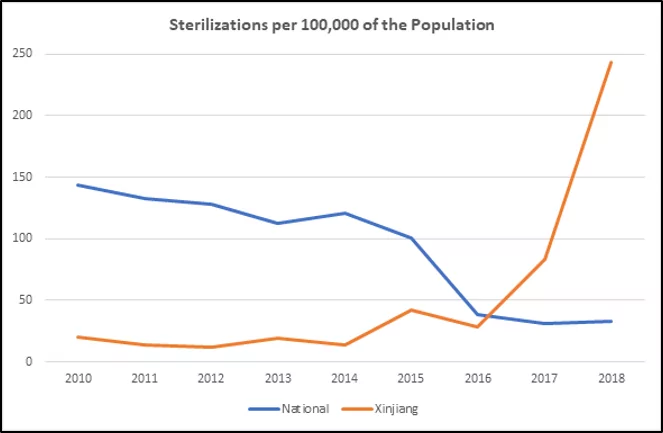
Overall, it is possible that Xinjiang authorities are engaging in the mass sterilization of women with three or more children – which make up approximately 19.7 percent of Uyghur females in China. [20] In past decades, women throughout China were pressured to submit to sterilization procedures once they had the maximum permitted number of children (Washington Post, October 29, 2015). Together with local and central government co-funding, project funds are sufficient to cover potentially up to nearly 200,000 tubal ligation sterilization procedures (priced at 600 RMB each). [21] It is likely that the project will continue beyond 2020—until the state’s birth prevention targets are reached.
In addition, rural women who “voluntarily” opt for sterilization after their second child, and hence forgo having a third child, receive one time payments of up to $700 (5,000 RMB) and ongoing annual cash rewards (Xinjiang Health Commission, January 5, 2018). In 2019 and 2020, Xinjiang’s Health Commission budgeted $104.7 and $102.4 million (750.4 and 733.9 million RMB respectively) for birth prevention award monies, including rewards for “voluntary” IUD placements and sterilizations.[22]
3. Conclusions
Xinjiang’s population control measures have enabled the state to increase or decrease minority population growth at will, akin to opening or closing a faucet. This contrasts sharply with a nationwide relaxation of birth controls in early 2016, when the country moved towards state encouragement for two-child families (China Brief, February 28). Xinjiang’s campaign to suppress minority population growth has been complemented with efforts to boost its Han population through increased births and in-migration. Additionally, regional authorities appear to encourage interethnic marriages (SupChina, August 7, 2019). In tandem, these three strategies appear to undergird a wider game plan of ethno-racial domination.
These findings raise serious concerns as to whether Beijing’s policies in Xinjiang represent, in fundamental respects, what might be characterized as a demographic campaign of genocide per the text of Section D, Article II of the U.N. Convention on the Prevention and Punishment of the Crime of Genocide.
Adrian Zenz is a Senior Fellow in China Studies at the Victims of Communism Memorial Foundation, Washington, D.C. (non-resident), and supervises PhD students at the European School of Culture and Theology, Korntal, Germany. His research focus is on China’s ethnic policy, public recruitment in Tibet and Xinjiang, Beijing’s internment campaign in Xinjiang, and China’s domestic security budgets. Dr. Zenz is the author of Tibetanness under Threat and co-editor of Mapping Amdo: Dynamics of Change. He has played a leading role in the analysis of leaked Chinese government documents, to include the “China Cables” and the “Karakax List.” Dr. Zenz is an advisor to the Inter-Parliamentary Alliance on China, and a frequent contributor to the international media.
First published on June 29, 2020. On October 2, 2021, the statement that in 2018, 80 percent of all net added IUD placements in China were performed in Xinjiang, was replaced with the statement that
in 2018, Xinjiang performed 963 net added IUD placements per 100,000 of the population, compared to a national average figure of 21.5.
Notes
[1] Source: Xinjiang 1990 Statistical Yearbook, table 3-1.
[2] Calculated based on Han household registered population figures (Figure 1).
[3] Xinjiang 2019 Statistical Yearbook, tables 3-1 and 3-8.
[4] There is no ethnic breakdown for permanent residents. A small number of these may have been Uyghurs who were forced to return to their original home regions from other parts of China in 2017 and 2018. However, it is unclear whether they had changed their household registration when they left Xinjiang in the first place, or whether their household registration was changed upon return to Xinjiang. While Xinjiang’s XPCC population also increased, their numbers are already included in Xinjiang’s overall household registered population (Urumqi City Government, June 4, 2019; XPCC Government, April 26). Urumqi’s 2019 figures only cite the permanent resident population (Xinjiang Government, June 8).
[5] While it is possible that citizens move their household registration to another province, converting their status in Xinjiang to that of permanent residence, the vast majority of permanent residents can be estimated to result from in-migration.
[6] All combined Kashgar and Hotan figures cited in this report are weighted based on total populations.
[7] Original Chinese: “通过2020年计划生育工作,人口控制明显,全州人口过快增长和违法生育得到有效控制,人口出生率和人口自然增长率同比下降7.13和6.4千分点… 人口自然增长率 ≤1.05%”. Given that the region’s 2019 birth rate stood at 8.18 per mille (https://archive.is/APGgL), the mandated 7.13 per mille reduction results in a 2020 target birth rate of 1.05 per mille. Source: www.xjkz.gov.cn. Archived download at https://bit.ly/2CbUaIz.
[8] Issued as 2018 no.2 document (新卫计生基层发〔2018〕2号). See e.g. https://archive.is/1I1mI. The original text of this directive is not publicly available.
[9] See e.g. https://archive.is/wip/uX06n or https://archive.is/wip/n6ATv. In theory, long-term effective birth control measures also include subcutaneous implants (皮下埋植). However, their adoption rate in Xinjiang is extremely low (Xinjiang Statistical Yearbooks tables 3-10). Local government birth control statistics between spring 2017 and autumn 2018 for 12 villages and urban districts in Kuqa County (Aksu Prefecture) do not show a single such case among a total of 5,477 married women of childbearing age.
[10] Original source: www.xjyl.gov.cn/info/1068/127191.htm. As social media post: https://archive.is/wip/iPIRT. Alternative download at https://bit.ly/2Wy4C4Q.
[11] Between March and May 2018, 36.0 percent of all those shown in the Karakax List as interned for birth control reasons were put into camps, as opposed to 22.5 percent of all detainees regardless of reasons (figures only pertain to those with a stated internment date). In May 2018, at least some regions also specifically mandated that all birth control violations since 1981 were now subject to “comprehensive clean-up investigations” (全面清理清查; Qapqal County Government, June 14, 2018).
[12] Chinese. 严厉打击违法生育行为,人口出生率和人口自然增长率大幅下降. Source: https://archive.is/hlcZi.
[13] Download page: https://archive.is/hfGL6 (file 2019年自治区卫生健康委员会机关及直属(管)单位绩效目标.xls). Archived download of the spreadsheet: https://bit.ly/31FcswE.
[14] 2015 and 2019 Health and Hygiene Statistical Yearbooks, table 8-8-2.
[15]2019 Health and Hygiene Statistical Yearbooks, table 8-8-2.
[16] Original Chinese: “引导广大农牧民群众自发进行计划生育绝育手术,实施节育手术免费政策,有效推进计划生育工作,有效控制人口过快增长”. Download page: https://archive.is/ZDatc. Archived download for the Word document: https://bit.ly/2YLKVXp.
[17] Spreadsheet download: https://web.archive.org/web/20200514143056/https://xjhfpc.gov.cn/system/resource/storage/download.jsp?mark=OTczMjg2ODhEREYzRTU0NEI2OURBNTk3NzA5RkYwMDQvNUExMURFNzkvNTZFMDA=. Overview and download page: https://archive.is/PuDlV. An earlier 2016 iteration was funded with 73.3 million RMB (source: https://archive.is/wip/tuiiF).
[18] Source: Guma County government website, download page at https://archive.is/F86ts, file 皮山县计生委.pdf contained in archive at https://www.ps.gov.cn/Upload/main/InfoPublicity/PublicInformation/File/2019/03/04/201903041238580250.rar. Alternative archived download at https://bit.ly/3fOCTEH. For both Guma County and Hotan City, the 600 RMB price tag shown in the respective government planning documents indicates that these are female sterilizations (输卵管结扎), which throughout Xinjiang are budgeted at a standard 600 RMB per procedure, while male sterilizations (输精管结扎) are budgeted at 220 RMB. See e.g. https://archive.is/wip/m2b9x.
[19] Source: https://web.archive.org/web/20200514171345/https://www.hts.gov.cn/file/upload/201904/02/161938677.pdf. See a similar document at (download page): https://archive.is/LqXLF. Alternative archived download at https://bit.ly/3fOqdxw.
[20] Source: Xinjiang 2019 Statistical Yearbook, table 3-9, assuming a 21.3 percent share of married females of childbearing age among a combined rural population (乡村人口) of 7.72 million. See also (Nilka County, November 20, 2019).
[21] The regionwide project also covers monthly subsidies for rural family planning propaganda workers (which are additionally co-funded from local budgets). If half of the regionwide project budget was earmarked for birth prevention services, 60 percent of these funds were available for sterilizations (versus 75 percent in Guma), and county co-funding averaged 20 percent (versus 50 percent in Guma), then this would amount to sufficient funds to perform 117,000,000 / 600 = approx. 195,000 tubal ligations. This would result in the sterilization of approximately 11.9 percent of all such women. Since co-funding may additionally also be provided by the respective prefectures as well as the central government, these are fairly conservative estimates. For example, Hotan Prefecture’s 2018 regionwide budget specified 72.9 million RMB for “family planning services” (计划生育服务; source: https://archive.is/wip/CMD8K). In 2019, Kashgar Prefecture 2019 spent 63.3 million RMB on this budget item, and for 2020 it budgeted: 74.3 million RMB on it (source: https://www.kashi.gov.cn/UploadFiles/News/2020/5/202005261307401203.zip or https://web.archive.org/web/20200618164959/https://www.kashi.gov.cn/UploadFiles/News/2020/5/202005261307401203.zip; archived download of the PDF at https://bit.ly/2NbIHes).
Kizilsu Prefecture received 1.33 million RMB in 2019 for birth prevention measures and such a propagation of free surgeries. Source: www.xjkz.gov.cn. Alternative download at https://bit.ly/3fzUJdK.
[22] 2019 figure: spreadsheet download at https://web.archive.org/web/20200514143056/https://xjhfpc.gov.cn/system/resource/storage/download.jsp?mark=OTczMjg2ODhEREYzRTU0NEI2OURBNTk3NzA5RkYwMDQvNUExMURFNzkvNTZFMDA=; overview and download page: https://archive.is/PuDlV. 2020 figure: download page: https://archive.is/LqXLF. Alternative archived download at https://bit.ly/3fOqdxw.




